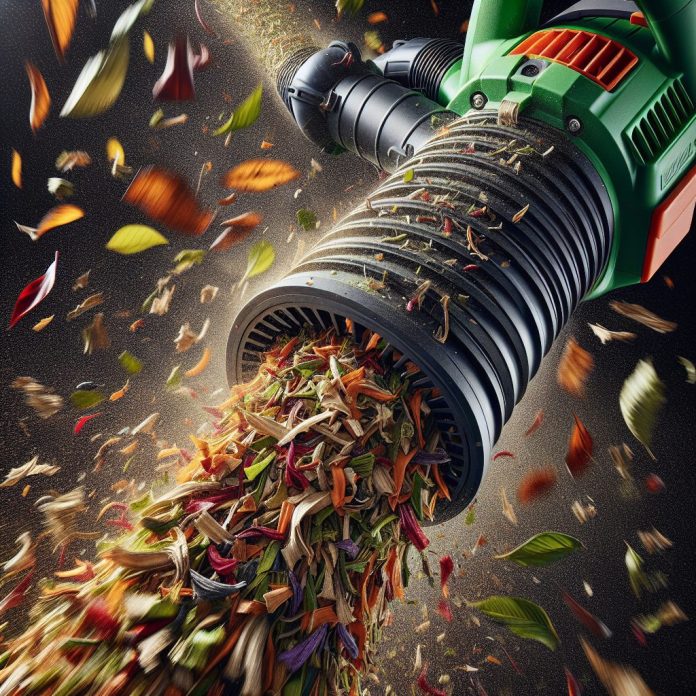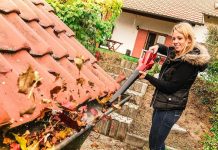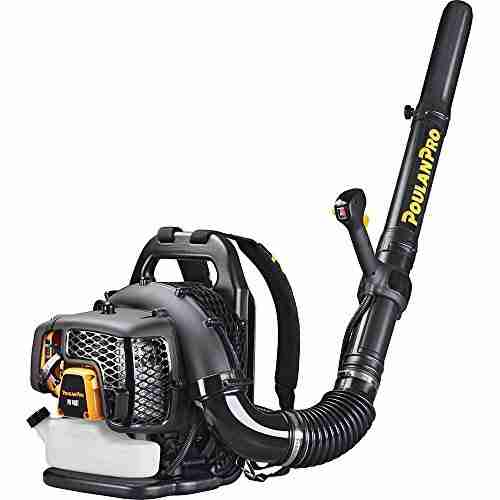Have you ever wondered if you can make the task of dealing with fallen leaves easier? Well, we have some good news for you: you can! In this article, we will explore the fascinating world of leaf blowers and uncover the surprising answer to the question: can you mulch leaves with a leaf blower? Get ready to discover a simple yet effective solution to your autumnal leaf woes!
What is mulching leaves?
Mulching leaves refers to the practice of using a leaf blower to shred and break down fallen leaves into smaller pieces. Instead of raking or bagging the leaves, mulching allows you to reuse them as a valuable resource for your lawn and garden. The process involves using a leaf blower equipped with mulching capabilities or attachments to shred the leaves into tiny fragments, which can then be left on the ground as a natural fertilizer and soil amendment.
Using a leaf blower for mulching leaves
Leaf blowers are versatile tools commonly used for clearing leaves and debris from outdoor spaces. However, when equipped with mulching attachments, they can serve an additional purpose – mulching leaves. A leaf blower with mulching capabilities is designed to collect, shred, and redistribute the leaves, making the mulching process efficient and hassle-free.
Leaf blower functions
A leaf blower has three primary functions – blowing, vacuuming, and mulching. The blowing function propels leaves and debris away from desired areas, making it easier to gather them in one location. The vacuuming function allows the leaf blower to suction up and collect leaves, providing a convenient method for leaf disposal. Finally, the mulching function involves shredding the leaves into smaller pieces, converting them into nutrient-rich mulch.
Mulching attachments for leaf blowers
To enhance the mulching capabilities of a leaf blower, various attachments are available in the market. These attachments include mulching kits, mulching blades, and mulching vacuum attachments. Mulching kits typically consist of a specialized fan and blade configuration that helps to shred the leaves more effectively. Mulching blades are designed to fit onto the leaf blower’s impeller, further optimizing the mulching process. Mulching vacuum attachments, on the other hand, enable the leaf blower to simultaneously collect and shred the leaves, simplifying the overall task.
Factors to consider when mulching leaves with a leaf blower
Before embarking on your leaf mulching journey, it’s essential to consider several factors that can impact the effectiveness of the process. Taking these factors into account will ensure that you choose the right leaf blower and achieve optimal results.
Leaf blower power and capability
The power and capability of the leaf blower are crucial factors to consider when mulching leaves. A more powerful leaf blower will be able to handle larger quantities of leaves and shred them more efficiently. It’s important to match the power of the leaf blower with the size of your yard and the volume of leaves you anticipate mulching. Additionally, considering the blower’s maneuverability and ease of use is essential to ensure a comfortable and efficient mulching experience.
Leaf blower mulching ratio
The mulching ratio refers to the reduction in leaf volume achieved by the leaf blower’s mulching capabilities. Different leaf blowers have varying mulching ratios, which determine the degree to which the leaves are shredded. A higher mulching ratio indicates that the leaves will be broken down into smaller fragments, resulting in a more effective mulch. When choosing a leaf blower for mulching, look for models with higher mulching ratios to achieve superior results.
Leaf blower vacuuming capabilities
If you intend to use a leaf blower with vacuuming capabilities for mulching, it’s important to consider its vacuuming efficiency. A leaf blower with a powerful vacuuming function will be able to collect a larger volume of leaves, reducing the need for multiple passes and increasing the overall efficiency of the mulching process. Look for leaf blowers with a high cubic feet per minute (CFM) rating, as this indicates a stronger vacuuming capability.
Types of leaves suitable for mulching with a leaf blower
While a leaf blower can generally handle most types of leaves, some variations are more suitable for the mulching process than others. Leaves that are dry, thin, and easily shredded are ideal for mulching with a leaf blower. Wet or dense leaves, such as those from evergreen trees, may be more challenging to shred effectively. It’s important to consider the type of trees in your yard and assess their leaf characteristics before deciding to mulch with a leaf blower.
How to mulch leaves with a leaf blower
Now that we understand the basics of mulching leaves with a leaf blower, let’s explore the step-by-step process to perform the task effectively.
Preparation
Before starting the mulching process, it’s essential to prepare the area and gather the necessary equipment. Clear any large debris, rocks, or branches from the ground to avoid damaging the leaf blower or impeding its performance. Ensure that the leaf blower is in good working condition, with the appropriate mulching attachments securely in place. It’s also helpful to wear protective gear, such as safety goggles and ear protection, to safeguard against flying debris and excessive noise.
Mulching technique
To mulch leaves effectively with a leaf blower, follow these simple steps:
-
Start by clearing the leaves into a central area using the blowing function of the leaf blower. Push the leaves into piles, making them easier to manage during the mulching process.
-
Switch to the vacuuming function of the leaf blower to collect the leaves into a bag or collection chamber. Move the leaf blower slowly and consistently over the leaves, ensuring that they are suctioned up efficiently.
-
Once the leaves are collected, engage the mulching function of the leaf blower. The shredded leaves will then be expelled onto the ground as fine mulch. Move the leaf blower over the piles of leaves, distributing the mulch evenly.
-
Repeat the process until all the leaves have been mulched. Take breaks as necessary, particularly if working on a large area, to prevent the leaf blower from overheating.
Advantages of mulching leaves with a leaf blower
Mulching leaves with a leaf blower offers several advantages that make it a preferred method for leaf disposal and lawn maintenance. Let’s explore some of these benefits:
Time-saving
Mulching leaves with a leaf blower is significantly faster than traditional methods such as raking and bagging. The powerful suction and mulching capabilities of the leaf blower streamline the process, allowing you to complete the task in a fraction of the time. This leaves you with more time to enjoy your outdoor space or focus on other essential activities.
Saves physical effort
One of the most significant advantages of using a leaf blower for mulching is the reduction in physical effort required. Raking and bagging leaves can be a strenuous task, causing fatigue and potential strain on the body. Using a leaf blower eliminates the need for manual labor, saving you from backaches and sore muscles.
Improves soil health
Mulching leaves with a leaf blower provides a natural and cost-effective way to improve the health of your soil. The shredded leaves act as a protective layer, retaining moisture and preventing weed growth. As the mulch breaks down, it adds valuable organic matter to the soil, enhancing its structure, fertility, and ability to retain nutrients. This promotes a healthier environment for your plants and encourages beneficial microorganisms.
Enhances lawn appearance
Mulching leaves with a leaf blower not only benefits your soil but also enhances the overall appearance of your lawn. The finely shredded mulch creates a clean and manicured look, making your outdoor space more aesthetically pleasing. Additionally, the mulch helps to regulate soil temperature, reducing the risk of temperature fluctuations that can damage the grass.
Tips for effective leaf mulching with a leaf blower
To ensure optimal results when mulching leaves with a leaf blower, consider the following tips:
Choose the right leaf blower
Selecting a leaf blower that matches your specific requirements is essential for effective leaf mulching. Consider factors such as power, mulching ratio, vacuuming capabilities, and maneuverability when choosing a leaf blower for your needs. Reading reviews and seeking recommendations can also help you make an informed decision.
Use appropriate mulching attachments
Investing in high-quality mulching attachments designed for your leaf blower model is crucial for achieving optimal results. These attachments are specifically designed to enhance the mulching process and ensure efficient leaf shredding. Using compatible attachments will make the task easier and more effective.
Use the correct mulching technique
Proper technique is key to achieving effective results when mulching leaves with a leaf blower. Move the leaf blower slowly and evenly over the leaves, ensuring that they are thoroughly shredded. Taking your time and maintaining a consistent pace will maximize the mulching efficiency and the quality of the mulch produced.
Mulch leaves when they are dry
To ensure a smooth and effective mulching process, it’s best to mulch leaves when they are dry. Wet leaves tend to clump and clog the leaf blower, making the mulching process more challenging. Waiting for dry weather or using the leaf blower before rainfall can help you avoid these issues.
Consider mulching leaves multiple times
For heavier leaf coverage or larger piles, mulching the leaves multiple times can result in finer mulch and better nutrient distribution. Running the leaf blower over the leaves two or three times can further break them down and enhance their decomposition rate.
Common mistakes to avoid when mulching leaves with a leaf blower
To ensure a successful leaf mulching experience, it’s important to avoid common mistakes that can undermine the effectiveness of the process. Here are a few errors to steer clear of:
Not wearing protective gear
When operating a leaf blower, it’s crucial to prioritize safety. Neglecting to wear protective gear such as safety goggles and ear protection can put you at risk of eye injuries from debris and potential hearing damage from the noise generated by the leaf blower. Always wear the appropriate protective gear to safeguard yourself.
Using a leaf blower with insufficient power
Attempting to mulch leaves with a leaf blower that lacks sufficient power can lead to frustration and poor results. Low-powered leaf blowers may struggle to shred the leaves effectively, resulting in larger fragments that take longer to decompose. Invest in a leaf blower with adequate power to ensure efficient mulching.
Mulching leaves when they are wet
As mentioned earlier, mulching leaves when they are wet can create issues during the mulching process. Wet leaves tend to clump together and clog the leaf blower, making it less effective. Wait for the leaves to dry before mulching to ensure a smoother and more efficient experience.
Ignoring the mulching ratio
The mulching ratio of your leaf blower determines the degree to which the leaves are shredded. Ignoring this factor may result in less effective mulching. Make sure to select a leaf blower with a higher mulching ratio or appropriate mulching attachments to achieve finer mulch and promote better nutrient distribution.
Neglecting regular maintenance of the leaf blower
Regular maintenance is crucial to keep your leaf blower functioning optimally. Neglecting to clean and maintain the machine can lead to decreased performance and potential breakdowns. Follow the manufacturer’s recommendations for maintenance and clean the leaf blower after each use to prolong its lifespan and ensure consistent mulching results.
Alternative methods for leaf disposal
While mulching leaves with a leaf blower is an effective and beneficial method for leaf disposal, there are alternative approaches you may consider based on your specific circumstances. Here are a few common alternatives:
Raking and bagging
Raking and bagging is the traditional method of leaf disposal. It involves manually raking the leaves into piles and then collecting and bagging them for disposal or composting. This method can be time-consuming and physically demanding but may be preferred for smaller yards or in areas where mulching is not practical.
Composting
Composting is a sustainable and environmentally-friendly way to dispose of leaves. It involves creating a compost pile or using a compost bin to decompose organic matter, including leaves, into nutrient-rich compost. Compost can then be used as a soil amendment or mulch for plants. Composting requires time and patience, but it allows you to transform leaves and other yard waste into a valuable resource for your garden.
Using a lawn mower
If you have a lawnmower with mulching capabilities, you can opt to mulch leaves by mowing over them. The mower’s mulching blades will shred the leaves and disperse them on the lawn as fine mulch. This method is particularly useful when dealing with large quantities of leaves or when the leaves are too thick or wet for a leaf blower.
Hiring professional services
If you have a large yard, limited time, or physical limitations, hiring professional services for leaf removal and disposal can be a convenient option. Professional landscapers or leaf removal companies have the necessary equipment and expertise to handle leaf cleanup efficiently, giving you a well-maintained outdoor space without the hassle.
Conclusion
Mulching leaves with a leaf blower is a practical and efficient method for leaf disposal. By using a leaf blower with mulching capabilities or attachments, you can convert fallen leaves into nutrient-rich mulch that benefits your soil, saves time and physical effort, and enhances the appearance of your lawn. Remember to consider factors such as leaf blower power, mulching ratio, and vacuuming capabilities to ensure optimal results. Follow the proper mulching technique, and don’t forget to wear protective gear and maintain your leaf blower regularly. While mulching leaves with a leaf blower is an excellent option, alternatives such as raking, composting, using a lawn mower, or hiring professional services may be more suitable depending on your preferences and circumstances.




































